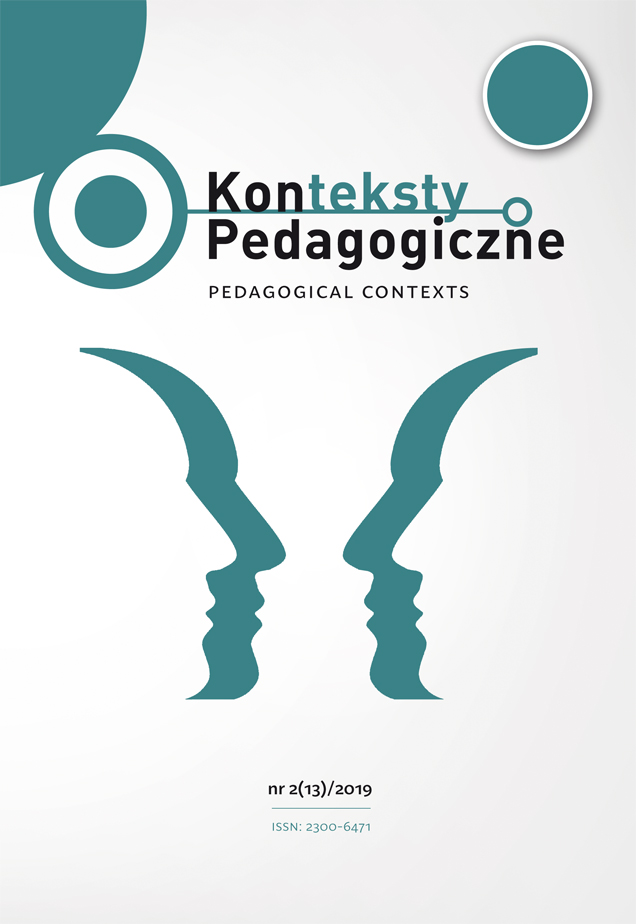Abstract
Depression, which is the main cause of suicidal behaviors, is becoming a serious social problem today, linked to approximately 90% of suicide cases. Current statistics and research indicate that the problem is escalating, affecting children, adolescents and adults. The complexity and multidimensionality of the determinants of depression and suicidal behavior require not only careful analysis, but, above all, the creation and implementation of effective prevention measures. The focus of the article, therefore, is on how to prevent depression and suicidal behavior in children and adolescents. On the basis of a careful review of current statistics and research on the subject, the paper offers original ideas on how to improve the existing preventive measures and lists some of the prevention programs which have been implemented in Poland and abroad. The effectiveness of these programs, as the author makes clear, depends on a variety of factors.
References
Christoffersen, M.N., Poulsen, H.D. and Nielsen, A. (2003). Attempted Suicide Among Young People: Risk Factors in a Prospective Register Based Study of Danish Children Born in 1966. Acta Psychiatrica Scandinavica, 11(108), 350.
Epstein, J.L., Sanders, M.G., Simon, B.S., Salinas, K.C., Jansorn, N.R. and Van Voorhis, F.L. (2002). School, Family, and Community Partnerships: Your Handbook for Action. California: Sage Publications.
Felcenloben, J. and Gmitrowicz, A. (2015). Realizacja Programu zapobiegania zaburzeniom depresyjnym dla dzieci i młodzieży w województwie łódzkim [Implementation of the Program for the Prevention of Depressive Disorders in Children and Youth in the Lodz Region]. Psychiatria i Psychologia Kliniczna, 15(3), 131–136.
Hołyst, B. (2007). Programy zapobiegania samobójstwom w amerykańskich szkołach [Suicide Prevention Programs in American Schools]. In: W.A. Brodniak (ed.), Zapobieganie samobójstwom. Poradnik dla nauczycieli i innych pracowników szkoły [Suicide Prevention. Guide for Teachers and other School Staff] (pp. 31–39), Warszawa: Biuro Rzecznika Praw Dziecka, Ministerstwo Edukacji Narodowej, Polskie Towarzystwo Suicydologiczne, Biuro Rzecznika Praw Dziecka.
Hołyst, B. (2012). Motywacje samobójstw nieletnich [Motivations for Juvenile Suicides]. Probacja, 3, 19–42.
Hooven, C., Walsh, E.M., Pike, K. and Herting, J.R. (2012). Promoting CARE: Including parents in youth suicide prevention. Family and community health, 35(3), 225–235.
Kalinowska, S., Nitsch, K., Duda, P., Trześniowska-Drukała, B. and Samochowiec, J. (2013). Depresja u dzieci i młodzieży – obraz kliniczny, etiologia, terapia [Depression in Children and Adolescents – Clinical Picture, Etiology, Therapy]. Annales academiae medicae stetinensis. Roczniki Pomorskiej Akademii Medycznej w Szczecinie, 59(1), 32–36.
Pospiszyl, I. (2009). Patologie społeczne [Social Pathologies]. Warszawa: PWN.
Prusik, A. (2015). Profilaktyka zachowań suicydalnych dzieci i młodzieży – wybrane obszary działań [Prevention of Suicidal Behavior in Children and Youth – Selected Areas of Activity]. In: M. Przybysz-Zaremba (ed.), Zachowania ryzykowne dzieci i młodzieży. Heterogeniczny wymiar oddziaływań profilaktycznych. Wybrane aspekty [Risky Behavior in Children and Adolescents. Heterogeneous Dimension of Preventive Actions. Selected Aspects] (pp. 95–110). Olsztyn: Wydawnictwo Prospekt PR.
Przybysz-Zaremba, M. and Katkonienė, A. (2014). Profilaktyka agresji i przemocy w szkole w optyce edukacyjnej [Prevention of School Aggression and Violence from Educational Perspective]. Społeczeństwo i Rodzina, 38(1), 48–62.
Przybysz-Zaremba, M. (2017). Zachowania suicydalne adolescentów – w kierunku „właściwej” profilaktyki (wybrane zagadnienia i działania) [Suicidal Behavior of Adolescents – Towards “Proper” Prevention (Selected Issues and Activities)]. In: I. Bieńkowska and J. Modrzejewska (eds.), Profilaktyczne aspekty zagrożeń bezpieczeństwa dzieci i młodzieży [Preventive Aspects of Threats to the Safety of Children and Young People] (pp. 55–71), Vol. 2. Kraków-Bielsko-Biała: Wydawnictwo Scriptum.
Przybysz-Zaremba, M. (2019). Uwarunkowania zachowań suicydalnych adolescentów – na podstawie przeglądu wybranych bada [Determinants of Suicidal Behavior in Adolescents – a Review of Selected Studies], Roczniki Pedagogiczne KUL, 11(47), 357–371.
Rogala, S. (1989). Partnerstwo rodziców i nauczycieli [Partnership of Parents and Teachers]. Warszawa: PWN.
Sánchez-Hernández, Ó., Méndez, F.X. and Garber, Y.J. (2014). Depression Prevention in Children and Adolescents: Review and Reflection. Journal of Psychopathology and Clinical Psychology, 19(1), 63–76.
Szymańska, J. (2012). Zapobieganie samobójstwom dzieci i młodzieży [Suicide Prevention in Children and Adolescents], ed. 3. Warszawa: Ośrodek Rozwoju Edukacji.
The National Police Headquarters. (2017). http://www.statystyka.policja.pl/st/wybrane-statyki/zamachy-samobojcze/63803,Zamachy-samobojcze-od-2017-roku.html [accessed: 20.08.2019].
Urban, B. (1995). Zachowania dewiacyjne młodzieży i podstawy profilaktyki [Deviant Behavior of Youth and The Basics of Prevention]. In: T. Sołtysiak (ed.), Zjawiska patologii społecznej. Uwarunkowania, rozmiary, profilaktyka, prognozy [Phenomena of Social Pathology. Conditions, Sizes, Prevention, Forecasts] (pp. 105–120), ed. 3. Bydgoszcz: WSP.
Veronica, S.C., Pisinger, M., Hawton, K. and Tolstrup, J.S. (2018). Self-harm and Suicide Behavior among Young People with Perceived Parental Alcohol Problems in Denmark: A School-based Survey. European Child and Adolescent Psychiatry, 2(27), 201–208.
In accordance with the recommendation of the Ministry of Science and Higher Education, which aims to counteract the practice of “ghostwriting” and “guest authorship,” all authors submitting their text for publication should attach an author’s statement which declares the contribution of each of the authors to the article. The printed and signed statement should be delivered by mail or other means to editor-in-chief Joanna Skibska or sent in the form of a scan to the following e-mail address: redakcja@kontekstypedagogczne.pl. The authors will not receive remuneration for publishing their papers. The editors reserve the right to make minor editorial changes to the articles which will not affect the substance of the article. We encourage all authors to prepare their articles in accordance with the guidelines for manuscript preparation. Download pdf file.
Authors transfer all copyrights and grant the journal the right of first publication with the work simultaneously licensed under a Creative Commons Attribution License that allows others to share the work with acknowledgement of the work's authorship and initial publication in this journal. All authors agree to the publishing of their email addresses, affiliations and short bio statements with their articles during the submission process.

